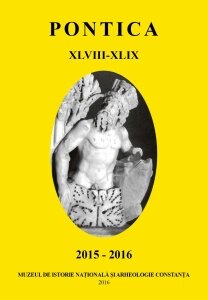Monede antice și bizantine din colecția Muzeului Național Brukenthal
Ancient and Byzantine Coins from the Brukenthal National Museum’s Collection
Author(s): Gabriel Mircea Talmaţchi, Claudiu MunteanuSubject(s): History, Anthropology, Social Sciences, Archaeology, Ancient World, Middle Ages
Published by: Muzeul de Istorie Națională și Arheologie Constanța
Keywords: Dobrudja; coins; 2nd BC ‐ 13th AD centuries;
Summary/Abstract: There are three batches of Roman and Byzantine coins (that we conventionally called A, B and C) in the numismatic collection of the National Museum of Brukenthal; two of them belonged to former private collections from Cisnădie (Carol Schultz) and Sibiu (Adam Walter), and the third one was part of the Astra National Museum Complex (ASTRA) collection. The latter is a donation from an unknown person made before 1950. The three batches have dobrudjan origins, according to their structure: denarii, Antoninianii, sestertii, asses, dupondii, 1st‐3rd century colonial bronze issues, folles and others reduced Roman coinage from the 4th century AD, but also 5th and 9th‐10th centuries AD byzantine bronze coins. These three collections were made by the same pattern. On one hand, we retain a big core made of various different value coins, of silver and common metals, medieval and modern, or even contemporary. On the other side, we recall a smaller core made of Roman and Byzantine coins, along with Turkish medieval and modern coins, modern Russian coins and, more important, modern and contemporary coins. Many of them are “exotic”, especially the Chinese and various Asian issues, which can only come from a commercial port, Constanţa in this case.
Journal: Pontica
- Issue Year: 2015
- Issue No: 48-49
- Page Range: 509-525
- Page Count: 17
- Language: Romanian

